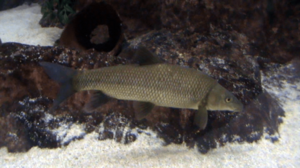Luciobarbus microcephalus facts for kids
Luciobarbus microcephalus is a special kind of fish that lives in rivers and lakes. It's also known as the small-headed barbel because of its scientific name. This fish is part of the Cyprinidae family, which includes many well-known fish like carp and minnows. It's a ray-finned fish, meaning its fins are supported by bony spines.
Quick facts for kids Luciobarbus microcephalus |
|
|---|---|
 |
|
| Conservation status | |
| Scientific classification | |
| Synonyms | |
|
Barbus microcephalus Almaça, 1966 (but see text) |
Contents
Meet the Small-Headed Barbel
This small barbel fish doesn't grow very big. When it's fully grown, it's usually less than 26 centimeters (about 10 inches) long. That's roughly the length of a standard ruler!
Where Does It Live?
The small-headed barbel is an endemic fish. This means it's found naturally in only one specific place in the world. For this fish, that place is the Iberian Peninsula, which includes Portugal and Spain.
You can find it mainly in the middle and lower parts of the Guadiana River's drainage basin. There's also a small group of these fish in a part of the Tagus River. Scientists think these fish might have been introduced there by people.
This fish likes to live in deep, slow-moving parts of rivers. It also makes its home in reservoirs, which are large artificial lakes created to store water.
Why Is It in Trouble?
Sadly, the number of small-headed barbels is going down. Because of this, the IUCN (International Union for Conservation of Nature) has listed it as a Vulnerable species. This means it's at risk of becoming endangered if we don't protect it.
Experts believe that by the year 2020, there might be less than half the number of these fish compared to the year 2000. This decline is mainly due to how we use water.
- Water pollution: Dirty water from farms or cities can harm the fish and their habitat.
- Water extraction: Too much water is taken from rivers for things like agriculture (farming). This leaves less water for the fish.
- Damming: Building dams on rivers changes the natural flow of water. This can block the fish's migration paths or change their habitat. Some planned dams, like one near Alquedi, could really hurt the fish population.
Another problem for the small-headed barbel is the introduction of other fish species. These "exotic" fish are not native to the area and can compete with the barbel for food or even eat them.
Protecting This Fish
To help protect the small-headed barbel, it's listed in Annex V of the European Union's Habitats Directive. This allows countries to control how many of these fish can be taken from the wild.
It's also listed as a Protected Species in Appendix III of the Convention on the Conservation of European Wildlife and Natural Habitats. This helps make sure that countries work together to protect this important fish.
See also
- Water supply and sanitation in Spain#Links to water resources


